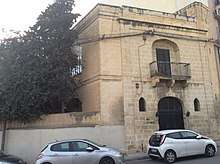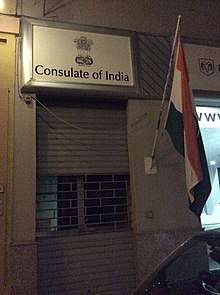Indian Maltese
|
| |
| Total population | |
|---|---|
| ca. 300 (2007) | |
| Languages | |
| English · Maltese | |
| Religion | |
| Hinduism | |
| Related ethnic groups | |
| Sindhi diaspora |
The Indian community in Malta (l-Indjani) was composed in 2007 of around only 200 persons (45 families) stemming from the town of Hyderabad, Sindh (in today's Pakistan) when Malta was a colony of the British. They are Maltese citizens and some reside in Malta since British times, originally as small textile traders.
Malta has a well-established small trading community of about 45 families of Indian Sindhi shop keepers that traces its roots to migration starting around 1887 when Malta was under British colonial rule and much after the arrival of Maltese in India following Britons take over of Malta in 1800. Apart from the small group of Sindhi Shop keepers no Indians from any other part of India had ever shown any interest in Malta. There are Memorials at Pieta Military Cemetery to Indians who fought for the British in World War I and died of wounds or illness in Malta. The bodies of 13 British Indian soldiers and seven men of the British Indian Labour Corps, were cremated at the Lazzaretto Cemetery on Manoel Island. Entry to Pieta Military Cemetery is in Triq II-Principessa Melita. Some of the Indians who died in Malta are Rifleman Dadrat Gurung,Havildar Jitbhadhur Thapa, Daffadar (Sergeant) Bal Ram, Driver Moti Lal, Driver Jai Ram and Labourer Khew Marak. On the partition of India by the British in 1947, Sindh was given to Muslim dominated Pakistan thus many Hindus in Sindh province fled and went to whichever country that was willing to take them that included Malta. While both countries were under British rule, Malta served as one of the trading roots for exporting silk. India made clothes were sought after by the Europe. However following India's independence, and due to strict immigration laws in Malta, no Indians visited Malta between 1952 and 1985.[1]
History
The Indian Maltese derive from the bahiband jati of the tiny Hindu Sindhi community. Following the British annexation of Sindh in 1843, a group of entrepreneurs from Hyderabad, Sindh set out for business opportunities in the rest of the Empire, originally trading in handicrafts from Sindhi (and hence becoming known as Sindhi workies), establishing a trade diaspora, facilitated by the new connection thanks to the Suez canal, the telegraph and the railway lines. Since the 1860s Hyderabadi traders soon set up business in Japan, Ceylon, Gold Coast, Gibraltar and Hong Kong.The Sindhi trade diaspora incercepted the growing tourism from Britain and Northern Europe in the Mediterranean as a profitable market for high-value Sindhi handicrafts. They later diversified into silk and curiosities, adding products from the Far East, such as Japanese ceramics and kimonos, to their catalogue. They also contributed to the growth of Gozo's Maltese lace industry, exporting it as far as Java and South Africa.[1]


In 1887 the firm Pohoomull Brothers applied to set up a shop in British ruled Malta. By 1910, more than 10 Sindhi firms had a business in British run Malta, which was a node in a global trade network. This small number of Sindhis held shops in the central shopping thoroughfare of Valletta, Strada Reale (later Kingsway, today's Republic Street) to cater for a high-end tourist market (a tyical shopfront sign would read "Grand Indo-Egyptian Persian Bazaar - Suppliers to the German Imperial Family"), as well as branch shops and itinerary peddlers. "From the time a ship dropped anchor to the time it left Malta, the visitor was tempted constantly by the Sindworkis' wares" (Falzon 2001). Maltese shops were local branches of the central firm, in Hyderabad, Sindh, from where personnel was selected (usually by kinship links) and sent to Malta for few years. Sindhi workers, as young as 15, used to share firm-provided housing in Valletta or Floriana, and migrant men were not allowed to bring along their spouses or dependants. Working time was extended (up to 15 hours a day, without any weekend) and workers were treated as personal servants by shop managers. Firms expected total loyalty from their employees and socialisation was not encouraged.[1] Sindhi Indians did not take part in the massive Maltese exodus out of Malta in the 19th century mostly to North Africa and the Levant
A change occurred in British ruled Malta in the 1930s: with the great recession, the tourist market subsided, and many enterprising Sindh shop keepers cut their investments in Malta. The shops were sold to former employees, ready to operate at smaller profits. Shops became family-owned. The partition of India did not lead to an influx of Sindhis (Malta was deemed too small to offer opportunities) and the strict immigration rules of the 1952-1985 period meant that only newly-wed men to Maltese Indian girls could move to Malta. Sindhi businesses adapted by diversification their product lines, to cater more for the domestic consumption of the Maltese, moving in the import, wholesale and retail of textiles.[1]
After the second world war, the Sindhis were ready to profit from the newly-found affluence of British ruled Maltese society, monopolising the textile trade. With the groth of female workforce in Malta since the 1970s, Sindhi traders introduce ready-made to cater for the lower-middle end of the market. Thanks to their network of trans-local trade, they soon became wholesalers of cloths and textiles for the Maltese retailers. The few firms which had remained in the trade of curiosities opened up since the 1980s to cheap electronics and adapted to the new influx of tourists in Malta in the 1970s and 1980s, moving into the souvenir market thanks to their long-held position on Valletta's thoroughfare. Further diversification and integration of Sindhi businesses within the wider Maltese economy is reported at the end of the 20th century.[1]

With the rapid rise of the Indian economy that rank third in GDP Purchasing Power Parity the Maltese government encourages Indians to set up business in Malta. Several Maltese trade missions often lead by Maltese Ministers frequent India. Malta has a big diplomatic presence in India since 2007 with a High Commission in New Delhi and a Consulate each in Mumbai, Chennai and Kolkata to develop cordial relations with India. Malta Enterprises has an office in India with the view of increasing trade and Indian investment in Malta. The Maltese efforts have been rewarded by a global Indian Pharmaceutical giant 'Aurobindo Pharma' build a USD 16 million plant in Hal Far, Malta that employs 120 Maltese and is linked to the University of Malta for training Pharmacy students. In order to attract Indian businesses Malta has offered various incentives to Indian companies. Malta has also signed a bilateral trade agreement with the Indian government, for the avoidance of double taxation. India now has a High Commission at Triq-Galanton Vassallo, St Venera that was previously thought unnecessary because of the tiny and insignificant Indian Sindhi Community and the size of Malta.
Associations
In 1955 the Sindhi traders in Malta gathered in the Indian Merchants' Association (Malta), as the links to Hyderabad had been severed with the Partition. The association was never particularly active, and in 1989 it was renamed the Maltese-Indian Community with following address: 1st floor, 'Sukh Sagar', 'The Maltese-Indian Community Centre', 25 Triq Bella Vista, San Gwann SGN 2690 , marking the shift towards the self-perception as a localised ethnic group. Today it organises Diwali festivals and the community centre.[1]
Culture
The small community continues to maintain Indian traditions in Malta, such as organizing celebrations of Diwali, Holi[4] Onam[5] and other Hindu festivals. Hinduism and religions of Indian origin are not recognised in Malta and described as cults,[6] A 1st floor flat 'Sukh Sagar' is the Maltese-Indian Community Centre, 25 Triq Bella Vista, San Gwann SGN 2690 holds Hindu meetings and prayers. After British left Malta the Hindu deceased are buried instead of being cremated as required by Hindu religion, that is of much concern to the Indian community worldwide.
See also
References
- 1 2 3 4 5 6 Falzon 2001, pp. 73-92
- 1 2 Leone-Ganado, Philip (25 May 2018). "19th century mural to be preserved". Times of Malta (25, 676). p. 3.
- ↑ "Save the graffiti". Timesofmalta.com. Retrieved 13 September 2018.
- ↑ "Malta's Indian community heralds spring with colour". Timesofmalta.com. Retrieved 13 September 2018.
- ↑ "WATCH: Kerala Indians in Malta celebrate Onam Festival. - TVM News". Tvm.com.mt. Retrieved 13 September 2018.
- ↑ "Hindus seek Pope's intervention to bring equality of religions in Malta". Timesofmalta.com. Retrieved 13 September 2018.
- ↑ "Seeing is believing - €2 million wedding in Malta - TVM News". Tvm.com.mt. Retrieved 13 September 2018.
Bibliography
- Falzon, Mark-Anthony (Autumn 2001). "Origins and establishment of the Indian business community in Malta". Bank of Valletta Review. 24. Archived from the original on 2010-02-01.